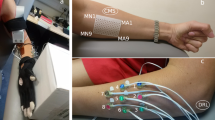Abstract
Pairs of electrocutaneous codes suitable for dual-channel sensory communication systems were compared using a dual-channel electrocutaneous tracking task. The tracking task required the test subject to dynamically respond to changes in the tactile sensation being modulated by two independent pseudorandom signals, one for each channel. The rule (or method) by which the signals changed the tactile sensations was called an electrocutaneous code. Four frequency variation codes and two intensity variation codes were paired in different combinations and then checked as to their effectiveness for sensory communications. The experimental protocol used a balanced incomplete block design which involved 24 subjects testing 3 of 8 code pairs each. Although the variance in the tracking performances between subjects was larger than the differences between the code pairs, learning rates for the various pairs were significantly different. The easiest one to learn was the Low Pulse Rate Modulation Code paired with itself. Other findings included the general superiority of monophasic stimulation code pairs over biphasic stimulation code pairs, the need for placement of the two electrodes on different dermatomes in order to achieve satisfactory dual-channel communications, and the greater sensitivity to electrocutaneous stimulation of the ventral side of the forearm versus its dorsal side.
Similar content being viewed by others
References
Beeker, T.W., J. During, and A. den Hertog. Artificial touch in a hand prosthesis.Med. Biol. Eng. 5:47–49, 1967.
Cochran, W.G. and G.M. Cox.Experimental Designs. London: John Wiley & Sons, 1950, pp. 259–273 and 315–345.
Collins, C.C. Tactile television: Mechanical and electrical image projection.IEEE Trans. Man-Mach. Syst., MMS-11(2):85–91, 1970.
Collins, C.C. and J. Madey. Tactile sensory replacement. Proceedings of the San Diego Biomedical Symposium 13:15–26, 1974.
Collins, C.C., L.A. Scadden, and A.B. Alden. Mobility studies with a tactile imaging device. Proceedings of the 4th Conference on Systems and Devices for the Disabled. Seattle, Washington, 1977.
Kato, I., M. Kumamoto, S. Tamura, and Y. Tsunekawa. Human cognitional ability for electric stimulation signals. In Proceedings of the 3rd International Symposium on External Control of Human Extremities, edited by M.M. Gavrilovic and A.B. Wilson. Belgrade, Yugoslavia: ETAN, August 1970, pp. 68–84.
Kato, I., S. Yamakarra, K. Ichikawa, and M. Sano. Multifunctional myoelectrical hand prosthesis with pressure sensory feedback system. In Proceedings of the 3rd International Symposium on External Control of Human Extremities, edited by M.M. Gavrilovic and A.B. Wilson. Belgrade, Yugoslavia: ETAN, August 1970.
Melen, R.D. and J.D. Meindl. Electrocutaneous stimulation in a reading aid for the blind.IEEE Trans. Biomed. Eng., BME-18 (1):1–3, 1971.
Pfeiffer, E.A., C.M. Rhode, and S.T. Fabric. An experimental device to provide substitute tactile sensation from the anesthetic hand.Med. Biol. Eng. 7:191–199, 1969.
Prior, R.E., P.A. Case, and J. Lyman. Hook opening feedback for the below elbow amputee. Proceedings of the San Diego Biomedical Symposium 16:357–368, 1977.
Prior, R.E. and J. Lyman. Electrocutaneous sensory feedback for artificial limbs: Single electrode encoding of grasp force and hand position from an externally energized hand. Proceedings of the 5th International Symposium on External Control of Human Extremities. Dubrovnik, Yugoslavia: ETAN, August 1975.
Rollman, G.B. Electrocutaneous stimulation: Psychometric functions and temporal integration.Percept. Psychophys. 5:289–293, 1969.
Saunders, F.A. An electrotactile sound detector for the deaf.IEEE Trans. Audio Electroacoust. 21:285–287, 1973.
Saunders, F.A. Recommended procedures for electrocutaneous displays. In:Functional Electrical Stimulation: Applications in Neural Prostheses, edited by F.T. Hambrecht and J.B. Reswick. New York: Marcel Dekker, 1977, pp. 303–309.
Saunders, F.A., W.A. Hill, and C.A. Simpson. Speech perception via the tactile mode: Progress report. In:Sensory Aids for the Hearing Impaired, edited by H. Levitt, J.M. Pickett, and R.A. Houde. New York: IEEE Press, 1980, pp. 278–281.
Schmid, H.P. and G.A. Bekey. Tactile information processing by human operators in control systems.IEEE Trans. Syst. Man Cybern., SMC-8(12):860–866, 1978.
Schmidl, H. The importance of information feedback in prostheses for the upper limbs.Prosthet. Orthot. Inter. 1:21–24, 1977.
Scott, R.N., R.H. Brittain, R.R. Caldwell, A.B. Cameron, and V.A. Dunfield. Sensory-feedback system compatible with myoelectric control.Med. Biol. Eng. Comput. 18:65–69, 1980.
Solomonow, M., A. Freedy, and J. Lyman. Frequency modulated cutaneous orientation feedback for artificial limbs. Proceedings of the 11th Annual Conference on Manual control, NASA-Ames, Moffett Field, California, 1975.
Solomonow, M., J.S. Herskovitz, and J. Lyman. Learning in the tactile sense.Ann. Biomed. Eng. 7:127–134, 1979.
Solomonow, M., J. Lyman, and A. Freedy. Electrotactile two-point discrimination as a function of frequency, body site, laterality, and stimulation codes.Ann. Biomed. Eng. 5:47–60, 1977.
Sparks, D.W., P.K. Kuhl, A.E. Edmonds, and G.P. Gray. Investigating the MESA (Multipoint electrotactile speech aid): The transmission of segmental features of speech.J. Acoust. Soc. Am., 66:246–257, 1978.
Szeto, A.Y.J. and J. Lyman. Comparison of codes for sensory feedback using electrocutaneous tracking.Ann. Biomed. Eng. 5(4):367–383, 1977.
Szeto, A.Y.J., J. Lyman, and R.E. Prior. Electrocutaneous pulse rate and pulse width psychometric functions for sensory communications.Hum. Factors 21(2):241–249, 1979.
Szeto, A.Y.J., R.E. Prior, and J. Lyman. Electrocutaneous tracking: A methodology for evaluating sensory feedback codes.IEEE Trans. Biomed. Eng. BME-26(1):47–49, 1979.
Szeto, A.Y.J. and F.A. Saunders. Electrocutaneous stimulation for sensory communication in rehabilitation engineering.IEEE Trans. Biomed. Eng. BME-29(4):300–308, 1982.
Tachi, S., K. Tanie, and M. Abe. Experiments on the magnitude sensations of electrocutaneous stimuli.Bull. Mech. Eng. Lab., Japan. No. 30, 1978, pp. 1–10.
Tanie, K., S. Tachi, K. Komoriya, and M. Abe. Study of electrocutaneous parameters for application to dynamic tactual communication systems. In: Proceedings of the First Mediterranean Conference on Medical and Biological Engineering, edited by F. Denoth. Sorento, Italy, September 12–17, 1977, pp. 17–65 to 17–68.
Walpole, R.E. and R.H. Myers.Probability and Statistics for Engineers and Scientists, 2nd Edition. New York: MacMillan Publishing, 1978, pp. 374–377.
Author information
Authors and Affiliations
Additional information
This research was supported by a National Science Foundation Grant, ENG7908197 and completed in the Department of Biomedical Engineering, Louisiana Tech University, Ruston, Louisiana.
Rights and permissions
About this article
Cite this article
Szeto, A.Y.J. Electrocutaneous code pairs for artificial sensory communication systems. Ann Biomed Eng 10, 175–192 (1982). https://doi.org/10.1007/BF02367389
Issue Date:
DOI: https://doi.org/10.1007/BF02367389




